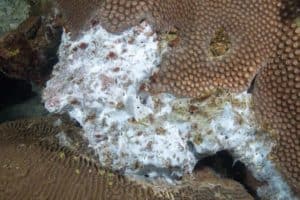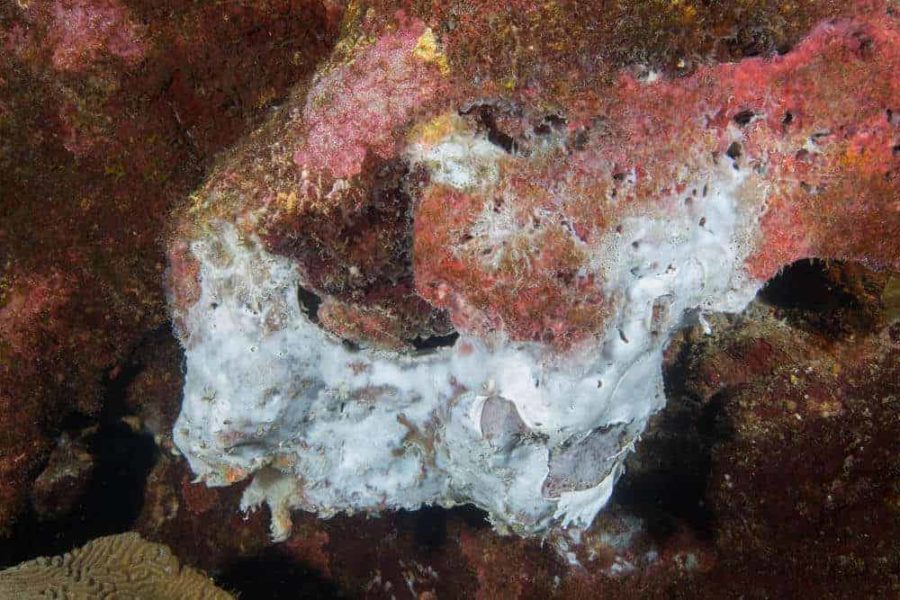On Monday, sport divers on the M/V Fling, diving in the Gulf of Mexico 100 miles offshore of Texas and Louisiana, were stunned to find green, hazy water, huge patches of ugly white mats coating corals and sponges, and dead animals littering the bottom on the East Flower Garden Bank, a reef normally filled with color and marine life. The reef, which is part of Flower Garden Banks National Marine Sanctuary, is considered one of the healthiest anywhere in the region.
The charter captain alerted scientists from the National Oceanic and Atmospheric Administration (NOAA) and Bureau of Ocean Energy Management (BOEM), who were doing annual monitoring work a few hundred yards away on the same reef. The scientists are now reporting that a large-scale mortality event of unknown cause is underway on this bank.
The divers and researchers found unprecedented numbers of dying corals, sponges, sea urchins, brittle stars, clams and other invertebrates on large but separate patches of the reef. Sanctuary Research Coordinator Emma Hickerson reported extensive white mats covering corals and sponges, and estimates the mortality of corals to be nearly 50 percent in some of the affected areas. The spatial extent of the event is still being determined, but Hickerson says the die-off has so far been seen at three dive sites that charter boats typically use when they visit the bank.
Oddly, there was no evidence of the mass die-off at the site used for long-term monitoring of the bank since the late 1980s, where the scientists had been working when they first heard the news. Annual monitoring at the sanctuary is co-funded by NOAA, BOEM and the National Marine Sanctuary Foundation. Twelve miles away, the reefs of the West Flower Garden Bank remain vibrant, bathed in clear, blue water and free of the problem for now.
Until the problem is sorted out, NOAA is recommending the public avoid diving, fishing, and boating activities on the East Flower Garden Bank. This is primarily to prevent the transmission of whatever is causing the mass mortality to unaffected locations, but also could protect divers from ingesting what could be harmful pathogens or toxins.
“At present, we are not aware of any specific risks to humans, but we are recommending this action as a precaution until more is known about the cause,” said G.P. Schmahl, Sanctuary Superintendent.

Several potential causes of the outbreak will be investigated, including poor water quality, disease pathogens and chemical spills. Each alone could cause mortality in coral reef organisms, but more likely, a combination of stressors is at work.
“We know of no spills that have recently occurred near the Flower Garden Banks,” said Schmahl, “but water temperature over the banks is quite high, at 86 degrees.” In addition, large plumes of low-salinity coastal water have moved offshore following months of extreme rainfall in the region. That water is rich with plankton, nutrients and chemicals that arrive to the Gulf through runoff and river discharges. As the plumes decay, oxygen levels in the water can decrease.
Combined, these stressors could make coral reefs animals and plants more prone to disease outbreaks, or simply fuel the growth of bacterial or algae mats that smother the reefs. Scientists from around the world are offering advice and assistance in trying to help discover the cause.
Isolated bleaching events and unconfirmed cases of diseases have been reported at the Flower Garden Banks in the past. Overall, however, the health and stability of the sanctuary’s invertebrate and fish populations have been in stark contrast to coral reefs around the world that have degraded over the last four decades.
Concern now is that the isolation of the banks, which many believe has been shielding them from human impacts, may not be enough to fully protect them anymore. But from what? The sanctuary and the science community are desperately trying to figure that out.


